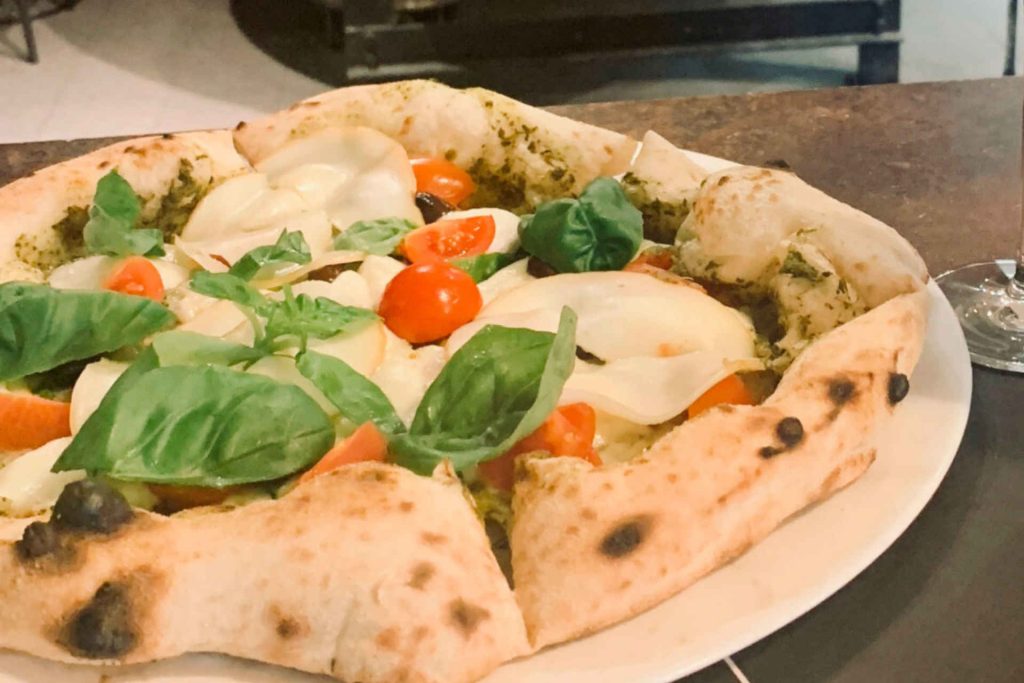
“At Pizzaiolo, we ferment the dough for even longer, namely 48 hours. This makes it wonderfully silky and soft.”
Raimondo Trombatore, host and chef at the “Pizzaiolo”
Together with chef Raimondo Trombatore, I had the opportunity to learn the craft of pizza making in his Graz restaurant “Pizzaiolo”. Together with his pizza baker Eros, he introduced me to the Neapolitan secrets. We prepared the “Ortolana”, a wonderfully colorful pizza with San Marzano tomato sauce, mozzarella “Fior di Latte”, melanzani, zucchini, peppers, basil, extra virgin olive oil – simply a poem.
Once we had shaped the pizza dough – only one person in the entire company has the secret pizza dough recipe – the delicious ingredients followed.
The reason why Raimondo, who was born in Sicily, now runs two restaurants in Graz was clearly love - love for a Styrian woman. “Pizzaiolo” opened the first original Neapolitan pizzeria in Styria on Dietrichsteinplatz in Graz in 2017, followed by his second ‘Pizzaiolo’ on Karmeliterplatz in Graz in 2019.
Only those who adhere to the specifications of the “Associazione Verace Pizza Napoletana” are allowed to sell their pizzas under this name. Not only are the ingredients and style prescribed, but also the dimensions of the pizza. When it comes to the mother of all pizzas, the Italians attach great importance to precision - the Verace Pizza Napoletana is a protected cultural asset that originated in Naples. A maximum diameter of 35 centimetres, a pizza base height of 0.4 centimetres (deviation +/- 10 percent) and a pizza crust height of 1-2 centimetres: these are the specifications of the “Verace Pizza Napoletana” association, which has members in 37 countries around the world.
The pizzeria “Pizzaiolo” also produces its pizzas according to the strict rules of the prestigious association, thus preserving the old Italian tradition of pizza baking. For example, the dough may only be made with a special flour. The water temperature must be between 20 and 22 degrees, medium hardness, pH value 6-7 and the dough must then ferment for at least 24 hours at 25 degrees.
But that's not all - if there are rules, then there are even more. This is because product quality is particularly important in Italian cuisine, which means that the essential foods used to top the pizza are also prescribed. They all have to come from Italy: Olive oil, San Merzano tomatoes from Campania and mozzarella fior di latte.
Last but not least is the pizza baking itself, which must take place in a certified pizza oven at 485 degrees. For a maximum of 90 seconds. The short duration at high heat keeps the food on the pizza fresh and simply delicious. In the pizza oven, the leopard pattern typical of Verace Pizza Napoletana is created on the edges: small, almost burnt areas and then light-colored dough again. And this is exactly what the taste is all about. In Italy, the crust is considered the best part of the pizza.

When Mediterranean lightness meets Andalusian temperament, the result is a menu that is more than just an arrangement of courses: it becomes a narrative about origins, freedom, and the longing for new perspectives. In December 2025, two-star chef Álvaro Salazar from VORO in Mallorca will take over as guest chef of the month at Restaurant Ikarus – and take Salzburg on a sensory journey between Andalusia and the Balearic Islands.
“Porto – The Cookbook” by Sylvie Da Silva brings the flavors of the Atlantic city to life in book form. The focus is not only on the food, but also on the culture behind it – from hearty home cooking to delicate monastery desserts.
The work captivates with its mixture of recipes and travel impressions. Each chapter takes readers on an enjoyable journey of discovery – including stories about ingredients, regions, and people. The balance between culinary depth and emotional closeness is particularly successful.
INFO
Porto – The Cookbook
Author: Sylvie Da Silva
Publisher: Südwest Verlag
192 pages, approx. 120 color photos
ISBN: 978-3-517-10389-1
Price: €24.00 (Germany) / €24.70 (Austria) / CHF 33.50
Imola is much more than just a race track: the city combines top-class cuisine, cultural monuments, and traditional producers to create an experience that delights connoisseurs, Italy fans, and curious travelers alike. From 2-star gastronomy at Ristorante San Domenico to creative pizza experiences and slow food osterie to historic libraries, palazzi, and award-winning wineries: this guide shows you the best places for cuisine, culture, and shopping—authentic, high-quality, and with real added value for your next visit to Imola.


Together with chef Raimondo Trombatore, I had the opportunity to learn the craft of pizza making in his Graz restaurant “Pizzaiolo”. Together with his pizza baker Eros, he introduced me to the Neapolitan secrets. We prepared the “Ortolana”, a wonderfully colorful pizza with San Marzano tomato sauce, mozzarella “Fior di Latte”, melanzani, zucchini, peppers, basil, extra virgin olive oil – simply a poem.
Once we had shaped the pizza dough – only one person in the entire company has the secret pizza dough recipe – the delicious ingredients followed.